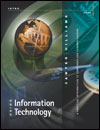 |  Using Information Technology Intro: A Practical Introduction to Computers and Communications, 5/e Stacey Sawyer
Brian K. Williams
FILES, DATABASES, & E-COMMERCE: Digital Engines for the New Economy
Web Summary- Managing Files: Basic Concepts. Data is organized in a data storage hierarchy of increasingly complex levels: bits, bytes (characters), fields,
records, files, and databases. A character is a letter, number, or
special character. A field consists of one or more characters (bytes).
A record is a collection of related fields. A file is a collection
of related records. A database is, as mentioned, an organized collection of
integrated files. Important to data organization is the key field, a field
used to uniquely identify a record so that it can be easily retrieved and
processed.
Files are given names -- filenames. Filenames also have extension
names, three-letter additions such as .doc and .txt. Among the types of
files are the following. (1) Program files are files containing software
instructions. The two most important are source program files, which contain
instructions in the form written by the programmer, and executable files,
which contain instructions that tell a computer how to perform a particular
task. (2) Data files are files that contain data. (3) Other common files
are ASCII files, which are text only; image files for digitized graphics;
audio files, which contain digitized sound; animation/video files, used
for conveying moving images; and Web files, which are files carried over
the World Wide Web. Two main ways in which a storage device accesses stored data are sequential
access and direct access. Sequential storage means that data is stored
and retrieved in sequence, as is the case with magnetic-tape storage. Direct access storage means that a computer can go directly to the information
you want, as in a CD player; hard disks and other types of disks are of
this nature. Whether on magnetic tape or disk, data may be stored offline or online.
Offline storage means that data is not directly accessible for processing
until the tape or disk has been loaded onto an input device. Online storage
means that stored data is randomly (directly) accessible for processing. - Database Management Systems. A database management system (DBMS)
consists of programs that control the structure of a database and access to
the data. The benefits of databases are file sharing, reduced data redundancy,
improved data integrity, and increased security. Databases can
be classified as four types. (1) An individual database is a collection
of integrated files used by one person. It could be a personal information
manager, which helps people keep track of information they use daily. (2)
A shared database, or company database, is shared by users in one organization
in one location. (3) A distributed database is stored on different computers
in different locations connected by a client/server network. (4) A public databank is a compilation of data available to the public; many such databanks
are Web sites.
- Database Models. Databases can be organized in four ways. (1) In
a hierarchical database, fields or records are arranged in related
groups resembling a family tree, with child (lower-level) records subordinate
to parent (higher-level) records. (2) A network database is similar
to a hierarchical database but each child record can have more than one parent
record. (3) A relational database relates, or connects, data in different
files through the use of a key field. (4) An object-oriented database
uses objects, software written in small, reusable chunks, as elements within
database files. An object consists of data in any form and instructions on
the action to be taken on the data.
- Databases & the New Economy: E-Commerce, Data Mining, & B2B Systems.
Databases underpin the so-called New Economy of computer, telecommunications,
and Internet companies in three ways: e-commerce, data mining, and business-to-business
(B2B) systems.
E-commerce, or electronic commerce, is the buying and selling of
products and services through computer networks; an example is Amazon.com.
Data mining is the computer-assisted process of sifting through
and analyzing vast amounts of data in order to extract meaning and discover
new knowledge. Data mining is used in applications ranging from marketing
to health to science. Business-to-business (B2B) systems allow businesses to sell to other
businesses, using the Internet or private network to cut transaction costs
and increase efficiencies. - The Ethics of Using Databases: Concerns about Accuracy & Privacy.
In morphing, a film image is altered pixel by pixel, so that the image
becomes something else. This manipulation of digitized images and sounds raises
some ethical issues. Sound performances can be misrepresented, photos may
be manipulated, and video and TV images may be altered in undetectable ways
and all stored in a database.
Databases are also limited in accuracy and completeness, since not all
facts can be found in a database, nor are all data items true. In addition,
databases raise several concerns about privacy.
|
|




 2002 McGraw-Hill Higher Education
2002 McGraw-Hill Higher Education